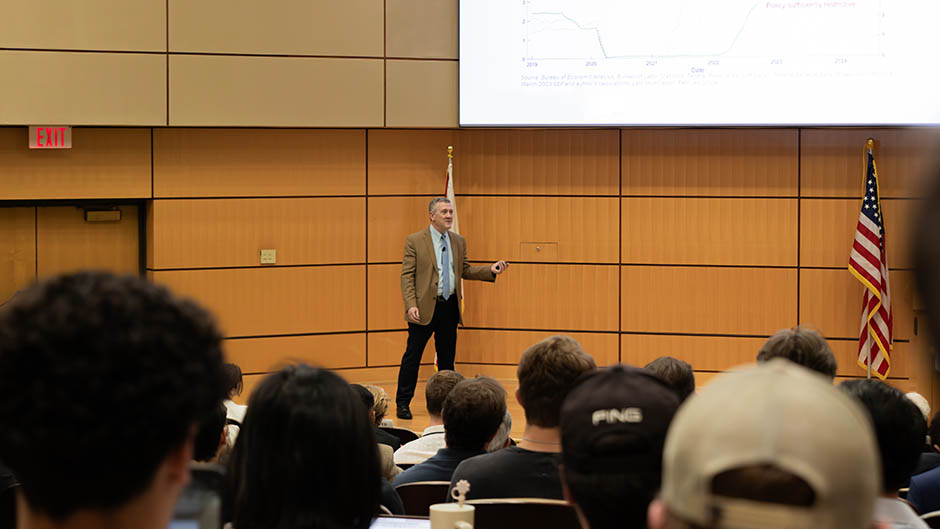James “Jim” Bullard, who headed the Federal Reserve Bank of St. Louis from 2008 to 2023, told a University of Miami Patti and Allan Herbert Business School audience that Fed interest rate hikes effectively corralled rising inflation, but have now outlived their usefulness.
“The main point of this talk is that…the current value of the policy rate looks too high,” said Bullard, who was introduced by Economics Department Chair David Andolfatto. “So, the basic message is that the policy rate has to be lowered and the FOMC (Federal Open Market Committee) has to get going, lowering the policy rate.”
Bullard, who last July became dean of Purdue University’s Mitchell E. Daniels, Jr. School of Business, and Andolfatto were colleagues at the Federal Reserve Bank of St. Louis, where Andolfatto worked for 13 years before joining Miami Herbert two years ago.
“Now that inflation has come down, where should we set the policy rate?” Bullard asked. “That’s kind of a day-to-day question in financial markets and in monetary policy.” Thanks to a Federal Reserve rate-hiking campaign that unfolded in 2023, the Fed rate is currently 5.25 percent to 5.50 percent, its highest level in 22 years.
Armed with a laser pointer, Bullard strode across the Storer auditorium stage as he reviewed slides made from data he’d culled from the nation’s 12 Federal Reserve Banks, the U.S. Bureau of Labor Statistics, and the U.S. Department of Commerce’s Bureau of Economic Analysis. Bullard posited that for the latter part of 2023, and all of 2024, the Fed failed to adhere to the Taylor Rule, a rate-setting equation formulated by Stanford economist John Taylor.
The Taylor Rule basically links the Federal Reserve’s benchmark interest rate to inflation and economic growth and has served as a roadmap for U.S. economic policy for more than three decades.
“Inflation went way up in 2021. This was after years and years of not having any inflation in the U.S.,” said Bullard, an economist and scholar who initially joined the Federal Reserve Bank of St. Louis as a researcher in 1990. “I think for many in this room, this was your first experience going to the store and being shocked at how much things cost. What happened was that inflation is the Federal Reserve’s policy, so the Federal Reserve had to take action to get inflation to come back down.
“Lo and behold, we applied the medicine and the medicine worked,” noted Bullard, who praised the Federal Reserve for aggressively tweaking short-term interest rates, in addition to its balance-sheet policy. “Inflation came down the last nine months or so by 200 basis points, a shocking amount.”
Delivering the second annual lecture of The Henry Family Endowed Speaker Series in Economics, Bullard said, “The problem is, a lot has happened in the last nine months. And the (Taylor) rule wants the policy rate to be adjusted in response to things that are happening out there in the economy.
“This big decline in inflation is not something that we have normally seen, but now that we have seen it, you’ve got to react, according to the policy rule,” Bullard said. “If you just take the policy rule…interest rates are too high. So, what does that mean? Mortgage rates are too high, and other types of loan rates are too high. They should be lowered, according to this rule.”
Bullard, whose talk was titled “Will Today’s U.S. Monetary Policy Achieve a Soft Landing?” indicated that this outcome is attainable as long as the Fed interest rate is lowered expeditiously.

